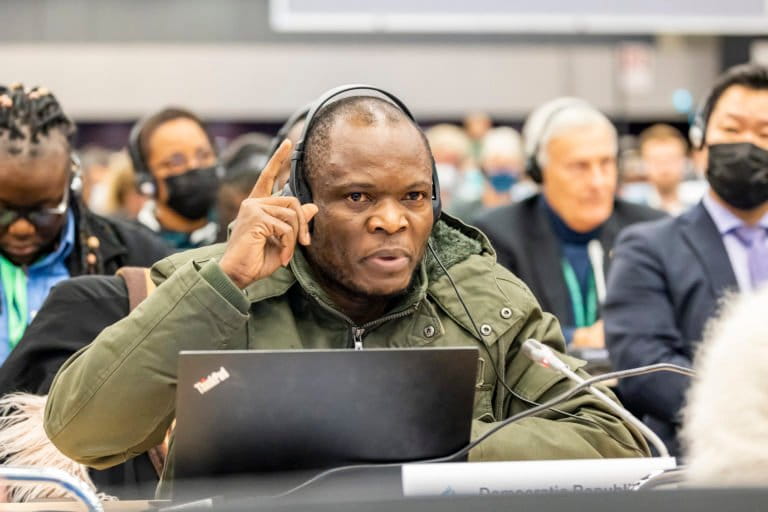- The Congo Basin holds the world’s second-largest rainforest — the majority of which is in the Democratic Republic of Congo (DRC) — playing a vital role in carbon storage and ecological services that millions of people and species rely upon.
- However, the DRC is a nation with the second-highest rate of tropical deforestation behind Brazil. Meanwhile, Gabon says it has acted to protect its forests but hasn’t reaped the promised rewards.
- International commitments to protect the Congo Rainforest are historically meager compared with what experts say is actually needed, and many of these commitments go unfulfilled.
- On this episode of Mongabay Explores the Congo Basin, we speak with experts about what’s needed to overcome hurdles to financing forest protection to benefit conservation, climate and communities: Paolo Cerutti, senior scientist and DRC unit head at the Center for International Forestry Research (CIFOR-ICRAF); Chadrack Kafuti at Ghent University; Wahida Patwa Patwa-Shah, senior regional technical specialist, UNDP Climate Hub; and Lee White, minister of water, forests, the sea and environment in Gabon.
How much does it cost to protect the Congo Rainforest? Where does the money come from? Who pays and how is that money used? What models of forest protection work? These are all questions examined on the latest episode in the Mongabay Explores podcast series on the Congo Basin.
To get a better understanding of how forest protection works (or doesn’t) in the Congo Basin, Mongabay spoke with Paolo Cerutti, principal scientist and DRC unit head at the Center for International Forestry Research and World Agroforestry (CIFOR-ICRAF); Chadrack Kafuti, Ph.D. student at Ghent University; Wahida Patwa-Shah, senior regional technical specialist, UNDP Climate Hub; and Lee White, Gabon’s minister of water, forests, the sea and environment.
Listen here:
Financing forest protection is, in a word, complex. Not only must one pay to keep forests standing and provide incentives to nations and local communities to continually manage and protect that forest, one must also consider the need for people to feed, clothe and house themselves. A standing forest you cannot touch doesn’t solve this issue.

Historically used models of protecting the Congo Rainforest are not without their problems. While national parks effectively protect a forest in a literal sense, the model has been criticized for its lack of inclusion of the needs of local communities and perpetuating violence and displacement.
International commitments and frameworks such as the Paris Agreement or the Kunming-Montréal Global Biodiversity Framework, while hailed as steps in the right direction, are not legally binding, are unlikely to be met and still fail to provide funding amounts to developing nations that experts say are needed.

REDD+, the UN program for reducing emissions from deforestation and forest degradation, initially heralded as a major step forward for being included in the Paris Climate Agreement, has struggled to generate the expected results. “Results-based payments” under article 5 of the Paris Agreement “do not exist” according to White, whose nation has not received any of those payments despite having them verified by the United Nations Framework Convention on Climate Change (UNFCCC) in 2022.
“They’ve been fully validated and recognized by the UNFCCC. We went through a three-year audit process with two different panels of independent experts nominated by UNFCCC. They congratulated us on the quality of our systems, but there are no results-based payments,” says White. “The international community has dangled a carrot in front of Gabon.”

So, where should the money come from exactly? The source, while important, doesn’t go far enough in addressing the problem, experts tell Mongabay in this episode. Translating money into action that benefits local communities needs to occur no matter where it’s coming from. That is not currently happening, says Cerutti.
“The problem today, for the past 50 or 60 years, has exactly been this: that we have come up with a lot of acronyms, a lot of things that have not contributed to a better livelihood for the local communities that live in these forests,” he says.
Subscribe to or follow Mongabay Explores wherever you get podcasts, from Apple to Spotify, and you can also listen to all episodes here on the Mongabay website, or download our free app for Apple and Android devices to gain instant access to our latest episodes and all our previous ones.
Listen to the previous episode in this podcast series here:
Sounds heard during the intro and outro: The call of a putty-nosed monkey (Cercopithecus nictitans). This soundscape was recorded in Ivindo National Park in Gabon by Zuzana Burivalova, Walter Mbamy, Tatiana Satchivi and Serge Ekazama Koto.
Banner Image: Proposed community conserved area. Ibola Dja Bana Ba Massaha in Gabon, one of Vietnam’s major timber-supply countries. Photo by ZB / Mongabay
Mike DiGirolamo is Mongabay’s audience engagement associate. Find him on LinkedIn, Bluesky, Instagram, TikTok and Mastodon.
